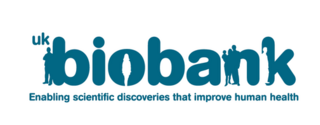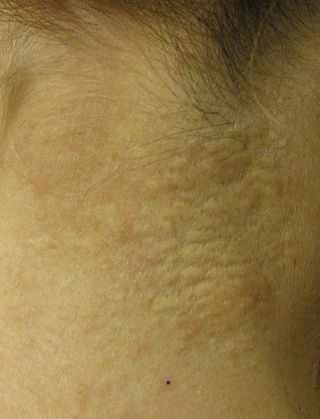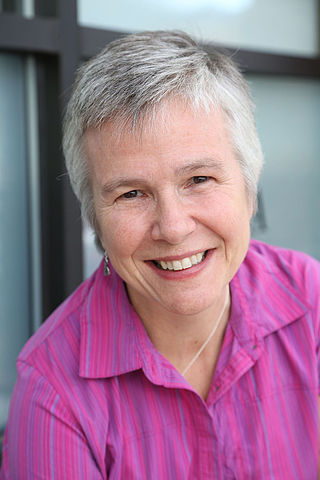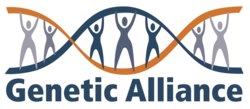
UK Biobank is a large long-term biobank study in the United Kingdom (UK) which is investigating the respective contributions of genetic predisposition and environmental exposure to the development of disease. It began in 2006.
DNA banking is the secure, long term storage of an individual’s genetic material. DNA is most commonly extracted from blood, but can also be obtained from saliva and other tissues. DNA banks allow for conservation of genetic material and comparative analysis of an individual's genetic information. Analyzing an individual's DNA can allow scientists to predict genetic disorders, as used in preventive genetics or gene therapy, and prove that person's identity, as used in the criminal justice system. There are multiple methods for testing and analyzing genetic information including restriction fragment length polymorphism (RFLP) and polymerase chain reactions (PCR).

Pseudoxanthoma elasticum (PXE) is a genetic disease that causes mineralization of elastic fibers in some tissues. The most common problems arise in the skin and eyes, and later in blood vessels in the form of premature atherosclerosis. PXE is caused by autosomal recessive mutations in the ABCC6 gene on the short arm of chromosome 16 (16p13.1).
Genetic discrimination occurs when people treat others differently because they have or are perceived to have a gene mutation(s) that causes or increases the risk of an inherited disorder. It may also refer to any and all discrimination based on the genotype of a person rather than their individual merits, including that related to race, although the latter would be more appropriately included under racial discrimination. Some legal scholars have argued for a more precise and broader definition of genetic discrimination: "Genetic discrimination should be defined as when an individual is subjected to negative treatment, not as a result of the individual's physical manifestation of disease or disability, but solely because of the individual's genetic composition." Genetic Discrimination is considered to have its foundations in genetic determinism and genetic essentialism, and is based on the concept of genism, i.e. distinctive human characteristics and capacities are determined by genes.
The Alliance for Aging Research is a non-profit organization based in Washington, D.C., that promotes medical research to improve the human experience of aging. Founded in 1986 by Daniel Perry, the Alliance also advocates and implements health education for consumers and health professionals.

The Arthritis Foundation is a nonprofit organization addressing the needs of people living with arthritis in the United States.

A biobank is a type of biorepository that stores biological samples for use in research. Biobanks have become an important resource in medical research, supporting many types of contemporary research like genomics and personalized medicine.
A Clinical Research Coordinator (CRC) is a person responsible for conducting clinical trials using good clinical practice (GCP) under the auspices of a Principal Investigator (PI).
The Solve ME/CFS Initiative is an American nonprofit that does research and advocacy for myalgic encephalomyelitis/chronic fatigue syndrome (ME/CFS), Long COVID, and other post-infectious diseases. Their stated mission is to assist research into ways to diagnose, treat, or cure these conditions. They also advocate for increased awareness, public funding of research, and access to medical care for patients.
A biorepository is a facility that collects, catalogs, and stores samples of biological material for laboratory research. Biorepositories collect and manage specimens from animals, plants, and other living organisms. Biorepositories store many different types of specimens, including samples of blood, urine, tissue, cells, DNA, RNA, and proteins. If the samples are from people, they may be stored with medical information along with written consent to use the samples in laboratory studies.
Generation Scotland is a biobank, a resource of biological samples and information on health and lifestyle from thousands of volunteer donors in Scotland.

Food Allergy Research & Education (FARE) is a non-profit, private organization dedicated to food allergy awareness, research, education, and advocacy. FARE's goal is to enhance the lives of people with food allergies by providing support and resources to help them live safe yet productive lives. FARE also includes information for people without food allergies, who are looking to not only be respectful of others but also become more educated and gain more awareness regarding healthcare and treatments. The organization provides information, programs, and resources about food allergies and anaphylaxis, a severe, potentially life-threatening allergic reaction. Working on behalf of more than 32 million Americans who have potentially life-threatening food allergies, FARE's mission is to improve the quality of life and health of those with food allergies and to provide hope for the development of new treatments and diagnostics.

P3G (Public Population Project in Genomicsand Society) is a not-for-profit international consortium dedicated to facilitating collaboration between researchers and biobanks working in the area of human population genomics. P3G is member-based and composed of experts from the different disciplines in the areas of and related to genomics, including epidemiology, law, ethics, technology, biomolecular science, etc. P3G and its members are committed to a philosophy of information sharing with the goal of supporting researchers working in areas that will improve the health of people around the world.

Sharon F. Terry is a health advocate in San Diego, California, United States. She co-founded PXE International when her children were diagnosed with pseudoxanthoma elasticum (PXE) in 1994. Her TEDMED talk from 2017 has been viewed more than a million times, and was the subject of the TED Radio Hour. In 2009, she was elected an Ashoka Fellow for her entrepreneurial work in engagement and the development of interventions for genetic conditions.
Biobank ethics refers to the ethics pertaining to all aspects of biobanks. The issues examined in the field of biobank ethics are special cases of clinical research ethics.
Return of results is a concept in research ethics which describes the extent of the duty of a researcher to reveal and explain the results of research to a research participant.
The National Database for Autism Research (NDAR) is a secure research data repository promoting scientific data sharing and collaboration among autism spectrum disorder (ASD) investigators. The project was launched in 2006 as a joint effort between five institutes and centers at the National Institutes of Health (NIH): the National Institute of Mental Health (NIMH), the National Institute of Child Health and Human Development (NICHD), the National Institute of Neurological Disorders and Stroke (NINDS), the National Institute of Environmental Health Sciences (NIEHS), and the Center for Information Technology (CIT). The goal of NDAR is to provide a shared common platform for data collection, retrieval, and archiving to accelerate the advancement of research on autism spectrum disorders. The largest repository of its kind, NDAR makes available data at all levels of biological and behavioral organization for all data types. As of November 2013, data from over 90,000 research participants are available to qualified investigators through the NDAR portal. Summary information about the available data is accessible through the NDAR public website.
Dynamic consent is an approach to informed consent that enables on-going engagement and communication between individuals and the users and custodians of their data. It is designed to address the many issues that are raised by the use of digital technologies in research and clinical care that enable the wide-scale use, linkage, analysis and integration of diverse datasets and the use of AI and big data analyses. These issues include how to obtain informed consent in a rapidly-changing environment; growing expectations that people should know how their data is being used; increased legal and regulatory requirements for the management of secondary use of data in biobanks and other medical research infrastructure. The approach started to be implemented in 2007 by an Italian group who introduced the ways to have an ongoing process of interaction between researcher and participant where "technology now allows the establishment of dynamic participant–researcher partnerships." The use of digital interfaces in this way was first described as 'Dynamic Consent' in the EnCoRe project. Dynamic Consent therefore describes a personalised, digital interface that enables two-way communication between participants and researchers and is a practical example of how software can be developed to give research participants greater understanding and control over how their data is used. It also enables clinical trial managers, researchers and clinicians to know what type of consent is attached to the use of data they hold and to have an easy way to seek a new consent if the use of the data changes. It is able to support greater accountability and transparency, streamlining consent processes to enable compliance with regulatory requirements.
DNA encryption is the process of hiding or perplexing genetic information by a computational method in order to improve genetic privacy in DNA sequencing processes. The human genome is complex and long, but it is very possible to interpret important, and identifying, information from smaller variabilities, rather than reading the entire genome. A whole human genome is a string of 3.2 billion base paired nucleotides, the building blocks of life, but between individuals the genetic variation differs only by 0.5%, an important 0.5% that accounts for all of human diversity, the pathology of different diseases, and ancestral story. Emerging strategies incorporate different methods, such as randomization algorithms and cryptographic approaches, to de-identify the genetic sequence from the individual, and fundamentally, isolate only the necessary information while protecting the rest of the genome from unnecessary inquiry. The priority now is to ascertain which methods are robust, and how policy should ensure the ongoing protection of genetic privacy.







